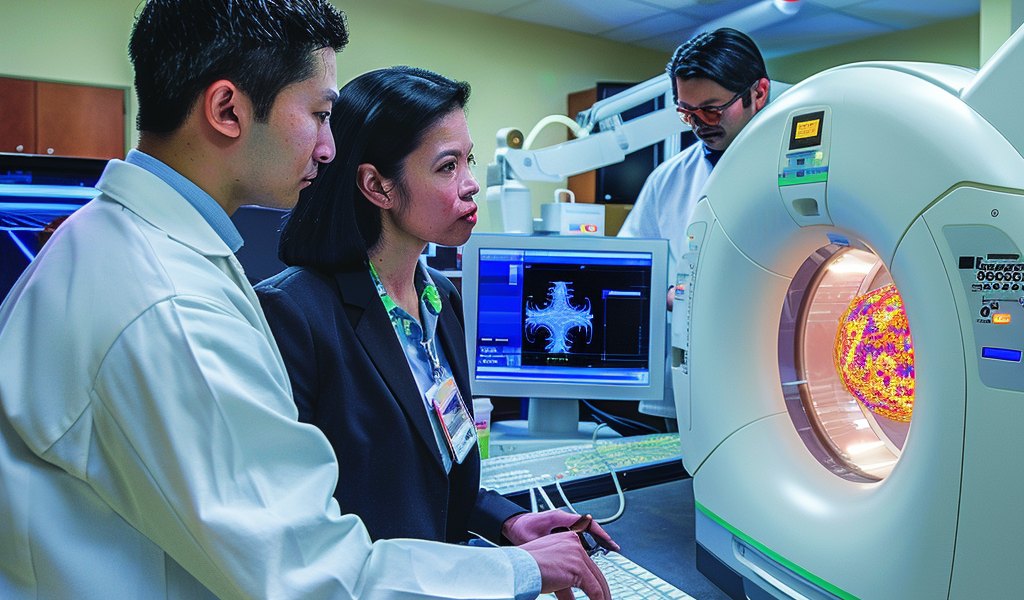In a groundbreaking study published in the journal Oncogene, researchers from the University of Cambridge have unveiled an innovative MRI-based imaging technology capable of predicting how ovarian cancer tumors respond to treatment. This advancement offers a rapid assessment of treatment effectiveness using patient-derived cell models, marking a significant step forward in personalized cancer care.
The imaging technique, known as hyperpolarized carbon-13 imaging, allows physicians to differentiate between various subtypes of ovarian cancer, revealing their unique sensitivities to treatment options. The study’s findings are based on a small-scale, unpublished investigation involving human ovarian cancer patients. Utilizing this advanced imaging method, scientists observed varying rates of pyruvate conversion into lactate across different tumor deposits, indicating the presence of distinct tumor subtypes.
Hyperpolarized carbon-13 imaging significantly enhances the signals detected by MRI scanners, boosting them by up to 10,000 times. This remarkable sensitivity enables researchers to distinguish between two forms of ovarian cancer, providing critical insight into their susceptibility to treatment. The team successfully applied this technique to patient-derived cell models that closely mimic high-grade serous ovarian cancer, the most prevalent and aggressive form of the disease.
One of the most notable applications of this imaging technology is its ability to identify whether a tumor is sensitive or resistant to carboplatin, the standard first-line chemotherapy drug for ovarian cancer. This rapid assessment empowers oncologists to evaluate a patient’s response to treatment and monitor its effectiveness within the first 48 hours, a crucial timeframe for making informed treatment decisions.
Traditionally, determining the effectiveness of ovarian cancer treatments has been a lengthy process, often taking weeks or even months. However, this innovative imaging method offers a faster alternative, enabling healthcare providers to personalize treatment plans within days. The ability to quickly assess treatment responses is particularly vital given the diverse ways in which ovarian cancer subtypes react to therapies.
In comparative studies, hyperpolarized carbon-13 imaging has demonstrated advantages over Positron Emission Tomography (PET), a commonly used clinical tool. Unlike PET, which has limitations in detecting metabolic differences between tumor subtypes, this new imaging technique provides a clearer picture of the tumor’s aggressiveness and can assess multiple tumors within a patient. Such comprehensive evaluations are essential for determining the most appropriate treatment strategies.
Kevin Brindle, the senior author of the study and a professor in the Department of Biochemistry at the University of Cambridge, emphasized the potential of this technology to transform the landscape of ovarian cancer treatment. By offering a deeper understanding of tumor characteristics and treatment responses, hyperpolarized carbon-13 imaging could significantly improve patient outcomes.
This advancement in imaging technology is particularly crucial for ovarian cancer patients, who often present with multiple tumors dispersed throughout the abdominal cavity. The ability to perform non-invasive assessments of these tumors can inform treatment decisions and enhance overall disease management.
As researchers continue to explore the capabilities of hyperpolarized carbon-13 imaging, the implications for clinical practice are profound. This technology not only promises to expedite the treatment evaluation process but also holds the potential to revolutionize personalized medicine in oncology. By tailoring treatment plans to the specific characteristics of a patient’s tumors, healthcare providers can enhance the likelihood of successful outcomes.
In summary, the development of AI-powered imaging techniques like hyperpolarized carbon-13 imaging represents a significant leap forward in cancer treatment. As researchers and clinicians work together to refine these technologies, the future of ovarian cancer care looks increasingly promising, with the potential for improved survival rates and quality of life for patients.





